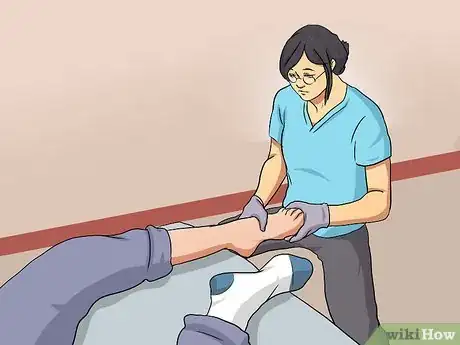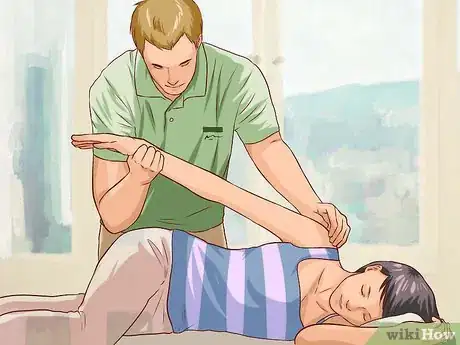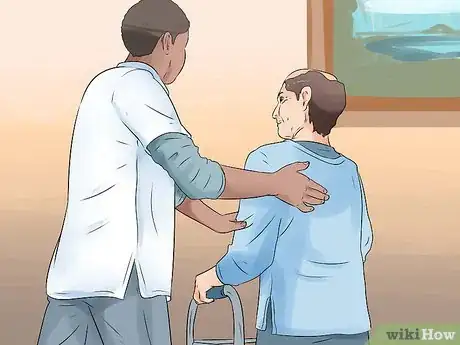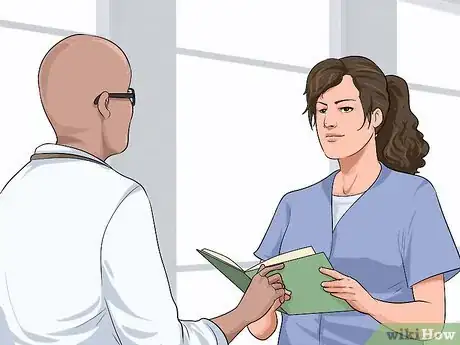This article was co-authored by Eric Christensen, DPT. Eric Christensen is a Physical Therapist based in Chandler, Arizona. With over a decade of experience, Eric works in both orthopedic and neurological fields and specializes in custom orthotic prescription and casting, vestibular reprogramming, and manual therapy. He holds a Bachelor’s degree in Exercise Science with a focus in Sports Medicine from Colorado State University and a Doctor of Physical Therapy from Regis University. In practice, Eric takes a developmental approach to rehabilitation utilizing the Selective Functional Movement Assessment. He uses functional movement patterning and manual therapy to return patients to prior levels of function.
There are 11 references cited in this article, which can be found at the bottom of the page.
This article has been viewed 44,785 times.
If you want to become a practicing physical therapist in the United States, you will need to obtain a doctor of physical therapy (DPT) degree. Earning this degree involves completing three years of coursework beyond a bachelor's degree and meeting the chosen university's requirement for hands-on practice with patients. The earlier you begin preparing for this program, the easier it will be to get in.
Steps
Fulfilling the Prerequisite Requirements
-
1Start focusing your studies in high school. If you are still a high school student, you can start working right now to improve your chances of being accepted into a DPT program in a few years. Choosing classes that relate to your future career and getting the best grades possible is an excellent way to start.
- Take as many science classes as you can in high school, especially AP classes. The more fundamental knowledge you have, the better prepared you will be for college-level classes.
- Don't neglect your other classes in favor of science classes. It's important to be well-rounded and have good grades in all your courses.
- A high GPA and good SAT or ACT scores will improve your chances of being accepted into an excellent undergraduate program, which will in turn prepare you for the graduate program that you want to pursue.
- You can also use your high school years as an opportunity to shadow professional physical therapists. Reach out to offices in your area and try to find a therapist who would be willing to let you observe their daily routine. This will give you a good idea of what it is really like to be a physical therapist.
-
2Complete a bachelor's degree program. In order to be accepted into a doctoral program in physical therapy, you will first need to complete an undergraduate degree. All doctoral programs have different prerequisite requirements, so it's a good idea to review the requirements at several schools before choosing your undergraduate major. In general, you will be required to take undergraduate courses in science fields such as biology, chemistry, anatomy, and physiology.[1]
- Especially relevant majors include biology, kinesiology, and exercise science, although you may have other options as well, depending on what programs are offered at your undergraduate school and what graduate school you hope to attend.
- If you are still in high school and you are certain that you want to pursue a doctorate degree in physical therapy, you may want to look into applying to a guaranteed admission program. These programs admit students as college freshmen for a six-year program that encompasses an undergraduate degree and a doctorate degree without the need to apply separately for the doctoral program.[2]
Advertisement -
3Work hard for good grades. Most reputable DPT programs are highly competitive, and undergraduate GPAs are heavily weighed by graduate program admissions officers, so it is extremely important to keep your grades as high as possible. Stay focused on your goals throughout your undergraduate years and maintain the highest GPA possible.[3]
- If you are struggling with your undergraduate classes, get help as soon as possible. Talk to your professors about what you can do to improve your grades or find out if there are peer tutoring services available at your university.
- Avoid overloading yourself with classes as an undergraduate if it causes your grades to slip. For example, if you can maintain a 3.6 GPA while taking 15 credits, but only a 3.2 while taking 18 credits, it may be wise to stick to the 15-credit course load.
-
4Gain experience in the field. Having some kind of experience in the physical therapy field or a closely related field can greatly improve your chances of being admitted to a doctoral program. You can gain experience by getting a part-time job, completing an internship program, or even volunteering.[4]
- Many programs will require that you complete observation hours before a DPT program. If this is required for the program that you will be applying for, make the most of this experience! Try to form a good relationship with the physical therapists you shadow, as you will probably need them to write recommendation letters for you.[5]
- In addition to helping you get into a doctoral program, gaining experience at the undergraduate level will also help you confirm that you enjoy working in the field, and it also may help you choose a specialty that you wish to pursue.
- Having experience in multiple settings may be even more beneficial, so seek out as many relevant opportunities as possible.
-
5Take the Graduate Record Examination. The Graduate Record Examination (GRE) is a test that is required for admission to most graduate programs, including DPT programs. Scores are valid for five years, so you can take it any time during your undergraduate studies. Be sure to prepare for this test and do as well as you can, as GRE scores are heavily weighed by admissions officers.[6]
- The GRE is a standardized test that consists of three sections: verbal reasoning, quantitative reasoning, and analytical writing.[7]
- Check online to find out what GRE scores you will need to be accepted into various DPT programs. Many schools post this information on their websites. If they don't post a minimum required score, they may post the average score of accepted applicants.
- You can retake the GRE if your score is not as high as you hoped it would be. The earlier you take the exam, the more chances you will have to retake it before you have to submit your applications to DPT programs.
- When you take the GRE, you can select to have your scores automatically sent to the schools that you plan on applying to. If you don't do this before you take the test, you will need to contact the company that administers the exam to have your scores sent to each school.
Applying to a Doctorate Program
-
1Decide which schools you will apply to. In general, it's a good idea to apply to several different DPT programs, as admissions are typically very competitive. Before applying, take a look at the admissions requirements online. If you are unsure if you will be accepted into the programs that you are most interested in, consider applying to several "safe" schools with less stringent admissions requirements as well.[8]
- When looking at schools, it is extremely important to ensure that they are accredited by the Commission on Accreditation in Physical Therapy Education (CAPTE). In order to sit for the exam that is required to obtain a license to practice physical therapy, you will need to graduate from an accredited program.[9]
- Some factors to consider when selecting the right school for you are graduation and employment rates, location, cost, and program size.
-
2Write your admissions essays. Most applications will require that you write at least one essay. Even if writing is not your strong point, be sure to take your time and write quality essays. Always read the requirements carefully to make sure that you answer all aspects of the question that is being asked and adhere to the required word count.[10]
- If you are asked to write essays on different topics for different schools, make sure your essay really fits the topic. Don't just tweak an essay that you used for another application if it doesn't fit!
- The most important thing you need to convey in your essays is a passion for the field of physical therapy. It's important that everyone who reads your essays understand why you want to pursue this career path instead of something else.
- If you have any doubts about the grammatical correctness of your essays, have them checked by a trusted friend or a professional editor. Your essays should be as polished as possible!
-
3Obtain letters of recommendation. Letters of recommendation are also a very important component of your application. Each program will have specific requirements for letters of recommendation, but they should generally come from college professors and/or professionals in the physical therapy field.[11]
- Ask professors who can speak to your ability to excel in a science-heavy curriculum and hands-on work with patients. The better the professors know you, the better their recommendation letters will be, so take some time to forge relationships with some of your professors.
- You may also need to obtain at least one letter of recommendation from a licensed physical therapist. This can be an individual that you shadowed during your observation hours, or an individual who you worked for in another capacity. These letters should highlight your aptitude for the field of physical therapy.
-
4Complete the applications. Once you have gathered all of the required materials, complete the application for each DPT program that you wish to apply for. Most programs now use The Physical Therapy Centralized Application Service's online application, which makes it easy to apply to multiple programs.[12]
- Be sure to submit all required documents before the application deadline. This includes transcripts, letters of recommendation, GRE scores, and any other documentation requested by the program.
- If there are multiple application deadlines, try to submit your application before the first deadline, as this may increase your chances of being accepted.
-
5Attend in-person interviews. Some programs interview you in person to gauge your capacity for grasping the curriculum and working with people in a healthcare setting. If you are asked to attend an interview, use this as another opportunity to convey your passion for the field of physical therapy to the admissions committee.
- Even if you don't have an interview, it's a good idea to visit each school that you are interested in and talk with the faculty. This will give you a much better idea of which school is the best fit for you.[13]
Completing a Doctorate Program
-
1Accept an offer. Once you've applied to DPT programs, you will need to wait for your decision letters before making any further plans. If you are only accepted into one program, you will have an easy decision, but if you are accepted into multiple programs, you will need to carefully consider which is the best fit for you.
- There are three possible outcomes of an application to a DPT program: you may be accepted outright, you may be rejected outright, or you may be wait-listed. If you are wait-listed, this means that you will be given a spot in the program only if enough of the accepted candidates decline their offers. You may have to wait some time to find out if you are accepted into these programs.[14]
- If you didn't get into any programs, don't give up! You may want to consider spending the next year gaining more clinical experience, and then applying to different programs.
-
2Complete the coursework. Most DPT programs take three years to complete. As a doctoral student, you can expect to spend about 80% of your time in the classroom and laboratory studying topics such as biology, physiology, behavioral sciences, finance, ethics, and sociology, and various evidence-based practices. [15]
- It's a good idea to work closely with your academic adviser to plan out your coursework.
-
3Fulfill the clinical fieldwork requirements. In addition to classroom work, you will be required to complete clinical fieldwork, which will constitute approximately 20% of your study time. This fieldwork will give you the opportunity to work with patients in a clinical setting under the supervision of licensed physical therapists. Each program has its own set of requirements.[16]
- During your fieldwork, you will essentially be an intern, working in a clinical setting such as a hospital or private office under the supervision of a licensed physical therapist. You will both observe your mentor and be observed as you interact with and treat patients.
- You may be required to present a case study report based on a specific case that you encountered during your fieldwork.
-
4Hone your personal skills. In addition to learning about the science behind physical therapy, you will need to learn how to interact with patients in order to be a successful physical therapist. Use your field work during graduate school as an opportunity to improve your communication skills.
- You will need to be especially careful about explaining things to your patients in ways that they can understand. Using too much industry jargon will only confuse them.[17]
- Consider asking your fellow students or supervisors for feedback on how you can improve the way that you interact with patients. Practice makes perfect, so do your best to implement their suggestions every day.
- If you struggle with interacting with patients, you may want to consider taking some additional courses. Studying sociology, psychology, or communications may help.
Advancing Your Career
-
1Take the National Physical Therapy Examination (NPTE). After you complete your doctoral program, the first step towards obtaining a license to practice physical therapy is to pass the NPTE. This is a computer-based multiple-choice exam that will test you on your knowledge of the practice of physical therapy.[18]
- If you do not pass the NPTE the first time, you may take it up to three times per year until you pass.
-
2Fulfill the other requirements for licensure in your state. Each state in the United States sets its own requirements for obtaining a license to practice physical therapy. After you pass the NPTE, you may need to take some additional steps in order to obtain the license. Check with your state for more details.[19]
- You may have to take additional exams beyond the NPTE. These exams may include questions about the laws that are specific to the practice of physical therapy in your state.
- You may also have to pass a criminal background check in order to be granted a license.
- Many states also require that physical therapists complete continuing education requirements in order to renew their licenses.
-
3Complete a clinical residency or fellowship program. If you want to gain even more knowledge and skills beyond what you acquired during your DPT program, you may choose to pursue a clinical residency or fellowship program. These programs are designed for licensed physical therapists who wish to develop their knowledge in a specific area of clinical practice.[20]
- Residency programs allow physical therapists to continue practicing under the guidance and mentorship of more experienced physical therapists. Fellowship programs include classroom instruction in addition to clinical work.
-
4Pursue a specialty certification. Once you are licensed, you will also have the option to pursue board certification in a sub-specialty of physical therapy. This is not a requirement to be a licensed physical therapist, but it can help you earn respect in your field and gain more specific knowledge.[21]
- Specialty areas include geriatrics, pediatrics, orthopedics, pulmonary and cardiovascular, women's health, neurology, clinical electrophysiology, and sports physical therapy.
-
5Make professional connections. If you want to continue growing your career and learning more about the field of physical therapy, it's important to stay connected to other industry professionals. There are many different ways to stay in the know, so take advantage of them.
- You can join professional organizations, such as the American Physical Therapy Association, which will help you stay up-to-date on the latest industry trends.
- You can subscribe to industry publications to stay informed. These may focus on a specific specialty of physical therapy or be more general, and many are available online for easy access.[22]
- You may also wish to attend periodic conferences for physical therapists. This will give you the opportunity to learn about what other professionals in the field are doing and to network.
Community Q&A
-
QuestionIs it compulsory to obtain a master's degree before going for a DPT?
 Brian Salazar-PrinceTop AnswererSome might require a master's depending on the program, but most DPT programs are pre-professional direct-entry programs which require a bachelor's degree prior to entry.
Brian Salazar-PrinceTop AnswererSome might require a master's depending on the program, but most DPT programs are pre-professional direct-entry programs which require a bachelor's degree prior to entry. -
QuestionI currently have a degree in PT. If I am willing to pursue a degree as a DPT, will that give me the privilege to evaluate a patient without them having to go to a doctor first?
 Brian Salazar-PrinceTop AnswererThe answer to your question is somewhat tricky. Yes, technically, you will have the ability to evaluate patients without an order from a physician; however, and it is a very large caveat, the willingness of third-party payers (medical insurance systems) in the US to cover care provided by you without a physician's order would likely be very limited. In essence, you could, but you would probably be limited to treating only private pay patients without a physician's order.
Brian Salazar-PrinceTop AnswererThe answer to your question is somewhat tricky. Yes, technically, you will have the ability to evaluate patients without an order from a physician; however, and it is a very large caveat, the willingness of third-party payers (medical insurance systems) in the US to cover care provided by you without a physician's order would likely be very limited. In essence, you could, but you would probably be limited to treating only private pay patients without a physician's order.
References
- ↑ http://blog.aftercollege.com/know-getting-doctor-physical-therapy-degree/
- ↑ https://www.medadmissions.pitt.edu/programs/guaranteed-admission-program
- ↑ https://www.youtube.com/watch?v=LETOeNFFIpo
- ↑ http://blog.aftercollege.com/know-getting-doctor-physical-therapy-degree/
- ↑ https://umdcareers.wordpress.com/2013/04/17/how-to-get-into-a-physical-therapy-program/
- ↑ https://umdcareers.wordpress.com/2013/04/17/how-to-get-into-a-physical-therapy-program/
- ↑ https://www.ets.org/gre/revised_general/about
- ↑ https://www.youtube.com/watch?v=LETOeNFFIpo
- ↑ https://www.capteonline.org/about-capte
- ↑ https://umdcareers.wordpress.com/2013/04/17/how-to-get-into-a-physical-therapy-program/
- ↑ https://umdcareers.wordpress.com/2013/04/17/how-to-get-into-a-physical-therapy-program/
- ↑ https://umdcareers.wordpress.com/2013/04/17/how-to-get-into-a-physical-therapy-program/
- ↑ http://www.apta.org/PTEducation/Overview/
- ↑ https://www.youtube.com/watch?v=LETOeNFFIpo
- ↑ http://www.apta.org/PTEducation/Overview/
- ↑ http://www.apta.org/PTEducation/Overview/
- ↑ http://www.kevinmd.com/blog/2013/05/4-tips-communicate-patients.html
- ↑ http://www.learnhowtobecome.org/physical-therapist/
- ↑ http://www.learnhowtobecome.org/physical-therapist/
- ↑ https://www.aucmed.edu/about/blog/what-is-medical-residency
- ↑ http://www.apta.org/PTEducation/Overview/
- ↑ http://physicaltherapyweb.com/physical-therapy-journals/











































































Medical Disclaimer
The content of this article is not intended to be a substitute for professional medical advice, examination, diagnosis, or treatment. You should always contact your doctor or other qualified healthcare professional before starting, changing, or stopping any kind of health treatment.
Read More...